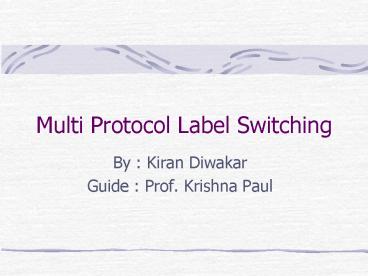Multi Protocol Label Switching - PowerPoint PPT Presentation
1 / 23
Title:
Multi Protocol Label Switching
Description:
Longest Prefix Match of hierarchical addresses. Search Time becomes ... Issue of network clogging. Can have a threshold after which flood. 9/29/09. 18. CR-LDP ... – PowerPoint PPT presentation
Number of Views:31
Avg rating:3.0/5.0
Title: Multi Protocol Label Switching
1
Multi Protocol Label Switching
- By Kiran Diwakar
- Guide Prof. Krishna Paul
2
Agenda
- Motivation and Introduction.
- Some Basic Terminology
- Working
- Application to Traffic Engineering.
3
Motivation
- IP forwarding is destination based.
- Longest Prefix Match of hierarchical addresses.
- Search Time becomes bottleneck.
- Different Forwarding techniques.
4
So why MPLS ?
- Elegant.
- Faster. How ?
- - Flat labels,Indexed lookup exact match
5
History
- Many approaches to label switching were
proposed - a. Toshiba Cell Switching Router
(1994) - b. Cisco Tag Switching (1996)
- c. Ipsilon Tag Switching (1996)
- d. IBM Aggregate Route-based IP
Switching (ARIS) (1996) - MPLS working group was established in
96 and IETF charter was passed in 97. - Finally the name MPLS was accepted
because neutral name was required.
6
Terminology
- Label Edge Router ( LER)
- Label Switch Router (LSR)
- Forward Equivalence Classes ( FEC ) Group of
packets . - Different granularities.
7
Terminology cont.
- Label 20 bit entity
- Label Switched Paths (LSP) Paths actually taken
by the packets in MPLS domain.
8
Setting Up an LSP
- Hop by Hop Normal LDP method.
- Explicit Routing Entire path is mentioned at
the ingress.
9
Label Distribution Protocol
- Label Request - Label for FEC .
10
(No Transcript)
11
Label Binding Types
- What is binding ?
- Local Binding Label assigned and used by the
router locally. - Remote binding Router receives bindings from
some other user.
12
Application to Traffic Engineering
- Some links congested while some links under
utilized.
13
Constraint Based Routing
- Find a path that satisfies constraints.
- - Attributes / Properties
- - Example attributes bandwidth, delay.
- Traffic Trunks used instead of the individual
flows.
14
Working
- Finds Shortest path tree using algorithm
15
Final Shortest Tree
- Either BC or CD can be removed.
16
Modifications for CSPF
- Along with distance check for constraints.
- Issues with multiple attributes.
- Constraint f ( a1,a2,a3.)
- What soln we get after applying constraint on
parameter a1,we apply the next constraint on a2 - Attributes are ordered as per priority policy
decision
17
Distribution of Attributes
- How to distribute the attributes?
- Can be piggybacked on routing updates.
- Can use flooding mechanism like link state.
- Issue of network clogging.
- Can have a threshold after which flood.
18
CR-LDP
- It adds Explicit Routing Capability to LDP.
- Needs link state protocol.
- Creates ERO along with label request.
- ERO inserted into label request message.
19
Rerouting
- Why rerouting necessary?
- Problems with plain IP rerouting.
20
MPLS CR for Rerouting
- Label Stacking Capability is used.
21
Benefits
- Separation of two planes.
- What is the benefit?
- Protocol Independence
- Flexibility
- Modularity and hence scalability
- Layer2 performance and Layer3 connectivity
- Improves the price / performance characteristics
22
MPLS Products
- Cisco Both Edge and Core MPLS routers are
available. Traffic Engineering support is
provided. - Nortel Networks preserves the utility of existing
service provider infrastructure by linking
traditional data networks to MPLS networks - Data Connection Optical Networks
23
Thank You !!!































